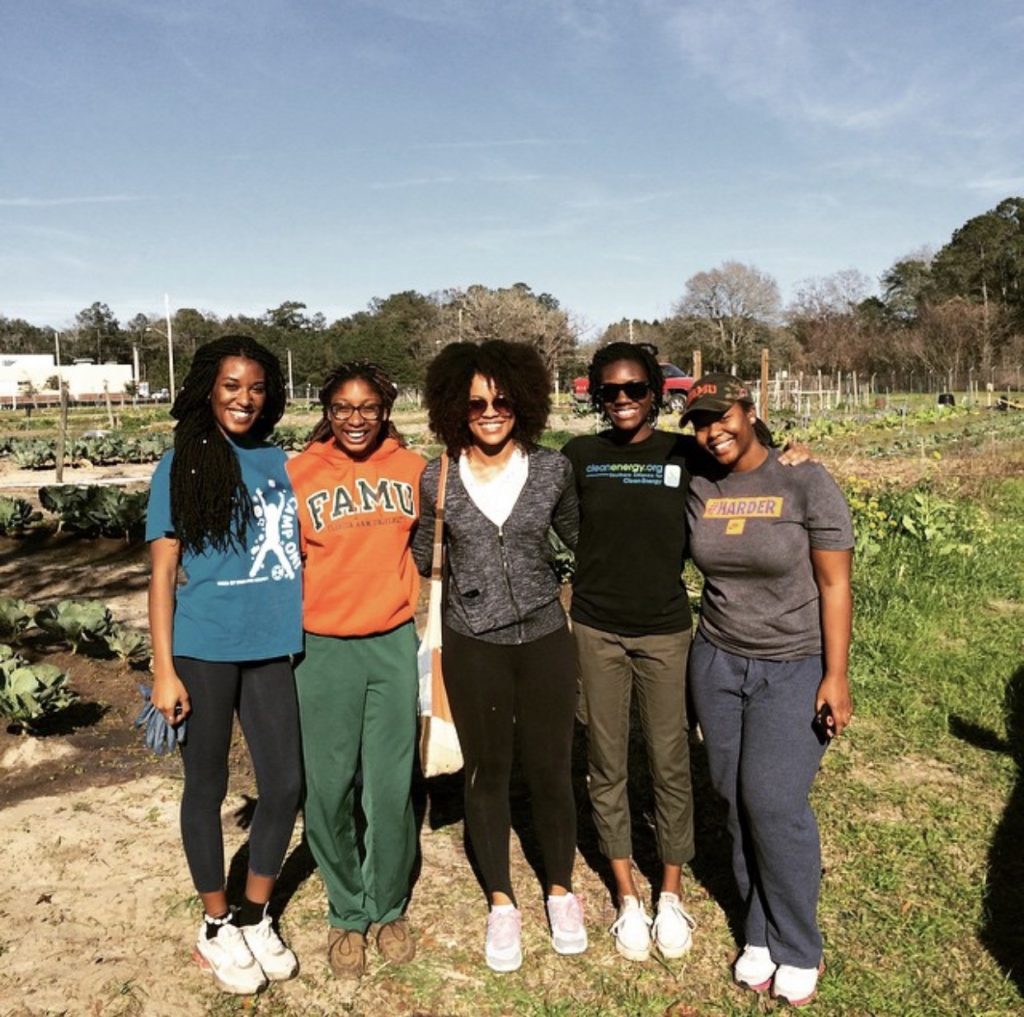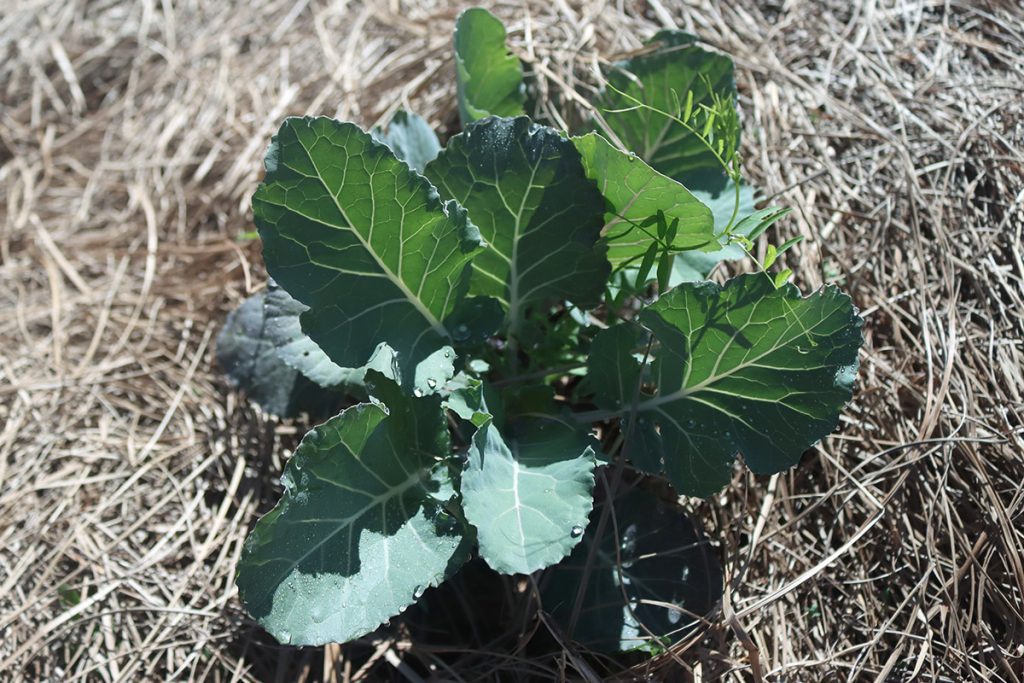I’m visiting Smarter by Nature in a time of transition. Rows of winter greens look ready for harvest, while spring seedlings wait to enter the ground. In a shady corner of the lot, Kip and Angelique methodically cut weeds with hand sickles. They work quickly, but they have several more rows to tackle with nothing but people power.
“Many people think that using hand tools is a lot of work,” Kip says. “But it’s not really, because we only do it twice a year. We have to bring new carbon into our soil”
He holds up a clump of ratty hay, explaining that when they first laid it over their rows, it did a good job suppressing weeds. Now it’s breaking down and adding to the soil. It now lets weeds grow as well, but Kip and Angelique welcome them.

“Since we weren’t using these beds in the first place, we’ve allowed the weeds to come.” Kip says. “Their root systems keep the soil intact while the soil is not being attended to.”
The roots of the docks, vetch, and medic plants keep the soil together. Vetch and black medic enrich the soil with nitrogen while alive, and then all the weeds add nitrogen after they’re chopped and left to decompose. The hay suppresses weeds and retains water for a few months before it too decomposes and adds carbon to the soil.
Notice the focus on soil.
In a previous segment, Herman Holley from Turkey Hill Farm said, “Composting really is the way to save the world!” Compost, of course, builds soil. And a growing number of people are paying attention to the benefits of healthy soil.

Land Stewardship and Social Justice
As students at Florida A&M University, Kip and Angelique studied seemingly unrelated fields.
“I really wanted to preserve and restore natural ecosystems,” Angelique says. “So I went to college to study environmental science.”
“For me, my major was sociology,” Kip says. “So we studied social inequality.”
Their interests came together when they traveled to New York City for the Global Climate in March, 2015. “I didn’t know what I was getting myself into,” Kip says. “I thought I was just taking a cool trip with the university and my friends. But I learned a lot about food systems in general, and how food security pertained to the community we lived in.
“We live on the south side of Tallahassee, which [is] considered a food desert. Which means that there’s no local fresh food available within a mile-and-a-half radius, in any given point in that space.”
“When we came back from that trip, we wanted to do something to address the food insecurity in our area.” Angelique says. “So we got together with about fifteen of our friends to start a student community garden.”

Learning about food systems and food insecurity in the context of climate change, their individual passions intersected, propelling them towards regenerative agriculture.
“Our passion was ignited,”Kip says, “and between addressing food insecurity and between stewarding the earth and studying its processes, that together created Smarter by Nature.”
Soil: One of the World’s Most Efficient Carbon Sinks
Those passions are rooted in healthy soil.
Soil’s ability to store carbon has been attracting a lot of attention in recent years. According to the Columbia University Climate School, “Earth’s soils contain about 2,500 gigatons of carbon—that’s more than three times the amount of carbon in the atmosphere and four times the amount stored in all living plants and animals.”
A lot of modern agricultural practices disturb soil and release the carbon stored within it. Large plantings of a single crop- known as monocropping- deplete nutrients in the soil, making them dependent on synthetic fertilizers. And tilling the soil- breaking it up to prepare it for planting- disrupts soil structure and its ability to store carbon.
Regenerative agriculture focuses on keeping soil intact, and building it. After our previous segments on the soils of Tallahassee and composting, I thought it would be interesting to see some soil conscious practices in action. There are many different approaches and philosophies when it comes to soil and growing food sustainably. Kip and Angelique are continuously testing new methods to see what works best in our area, and with an eye towards growing their business.
Likewise, different gardening practices work better for us in our different home spaces. With that in mind, let’s see what’s cooking at Smart by Nature.

The Smarter by Nature Tour
When you first walk onto the farm, you see three sections of raised beds covered with hay.
“We have thirty inch beds and eighteen inch pathways,” Angelique says. She and Kip are walking me through the farm. “We don’t want to disturb our soil season after season. We just want to leave our beds where they are and amend them.”
They amend with worm castings, phytoplankton, molasses, and Azomite (a mineral additive). They find that mounding the soil has benefits as well.

“Since our soil is really sandy,” says Kip, “water percolates. Minerals wash through real easily. So by building up the beds, we allow organic matter to be stored, kind of like a mound or a Hugelkultur.”
Hugelkultur is a technique where wood is allowed to decompose in a mound which later becomes a raised bed. Smarter by Nature tops off their mounds with a hay layer, which suppresses weeds and helps retain moisture.
“They say for every three inches of rain,” Kip says, “when you store hay on your space, it retains one inch of water over time into the soil.”
As Kip says in the video, different growers have success with different techniques. Compost and mulch also help soil retain moisture and enrich soil.

Solarization
We walk to the back of the center section, where a few rows are covered with a black tarp.
“We’re solarizing these beds right now.” Kip explains the process. “We weeded the bed right after it rained, so there’s moisture. What you do is you put a silage tarp over the beds, and over the course of six to eight weeks, it creates heat that causes whatever weed seeds are in the ground to germinate. But since they don’t have access to light and moisture, eventually they die.”

Kip and Angelique remove some bricks at the edge of the tarp and pull it up. Various plants have grown up under the tarp, and were smothered to death. There is also an ant pile and cool looking black slug dining on the remains.
It’s not uncommon for folks to lay cardboard over an area where they want to smother weeds. In this method, you’d cover the cardboard with leaves or mulch, and simply allow it all to decompose.
A Farm as an Ecosystem
Another core principle of regenerative agriculture is to have your farm or garden function as much like a natural ecosystem as possible.
Intact soil, for instance, contains a wealth of microbes and mycorrhiza. Mycorrhiza have received a lot of attention in recent years. These long strands of fungus grow around tree roots, and form a network between trees. They transmit water, nutrients, and chemicals between plants. When you see articles with titles relating to trees talking to each other, this is what they’re talking about.
Above the soil, a natural ecosystem is a combination of trees, shrubs, grasses, wildflowers, and succulent plants.
“One thing we like to do is incorporate a lot of different plants into our area, so that we don’t just grow annual crops” Angelique says. “On the ends of these beds we have moringa trees to provide some shade. Right now they’re cut, but they’ll come back when spring is here.” (We filmed this in early March 2021)
Moringa trees aren’t native to Florida, but they are drought resistant and grow quickly. Their shade will cool the plants beneath them, helping to conserve water.

Weeds and Wildflowers on the Farm
Nearby, Kip points out a row with a couple of clipped moringa trees. “This is our hedgerow,” he says. Many of the plants died back during the winter, but will soon start to resprout. The trees have been closely planted with a variety of pollinator plants. This tight planting serves as windbreak in the wide open space of the farm.
“One being the firebush, which is a native plant here in north Florida. We have our moringas, some turmeric. We have some purple coneflowers. We’re going to plant some basil in here. Last year we had Mexican sunflower.”
“We also had the blue plumbago and the yellow lantana,” Angelique says, “which the butterflies really loved.” There is a lantana species native to south Florida. Non-native Lantana camara is more commonly used in our area. It can spread, but nurseries do have sterile lantana for sale. In fact, I have a bed of sterile lantana in my yard and butterflies do love it.
Kip and Angelique have recently planted coneflowers and salvia at the ends of rows. “There’s a lot of native bees around here, a lot of butterflies,” Angelique says, “so we want to provide them with food.”
And of course they have a mix of weeds growing wild in their unused beds. If you’re hesitant about letting weeds take over a space, I recommend a post from earlier in the year about identifying and learning whether you want to keep or pull a plant that grows uninvited in your yard. It’s good to know what’s native, invasive, and which nonnatives have benefits- like the nitrogen fixing hairy vetch.

One Last Tip, Regarding Brassicas, that I’m Trying This Year
We’re now standing by rows of Brassicas- Brassica is the genus of plant that include broccoli, cauliflower, Brussels sprouts, kale, chard, cabbage, collard greens, mustard seed. I had some mixed success growing some in the yard this year, and I really want to try the next thing Kip says:
“We’re going to cut these plants at the base. Oftentimes, brassicas are looked at as annuals. I thought so, too, myself. But we clipped our collards and they started coming back on their own. So we’re going to do the same thing here.”
After hearing this, I was debating whether to relocate my clipped winter Brassicas or plant summer produce next to them in their current pots. I Googled cauliflower roots, and then the same for Brussels sprouts. It turns out that even though these plants can get huge and bushy, they have small root systems.
I’m excited to see whether they grow back in my yard.
Bridging Ethics, Building Towards Profit
Because they started the farm around the beginning of the Covid 19 pandemic, Kip and Angelique have managed the farm mostly on their own. They don’t use tractors or any other time saving machinery. This is in line with their climate conscious ethics, but it means more work.
It’s work they’re willing to put in, even if it means a slower road to profit.
“For someone starting out, it’s not profit,” Kip says. “It’s mostly learning, and learning how to bridge your system together, how to bridge your ethics.”
Building that system has a value beyond dollars, but one they believe will translate to higher financial earnings down the road.
“One of the profits is the intrinsic value of gaining wisdom over time,” he says. “I mean, we sell food. That’s number one. It’s just that the money goes back to our business. So it’s not like I need profit to go on a cruise or something. It’s profit to feed back into our business.”

Dig Deeper into Backyard Ecology
What can we do to invite butterflies, birds, and other wildlife into our yards? And what about the flora and fauna that makes its way into our yards; the weeds, insects, and other critters that create the home ecosystem? WFSU Ecology Blog takes a closer look.
